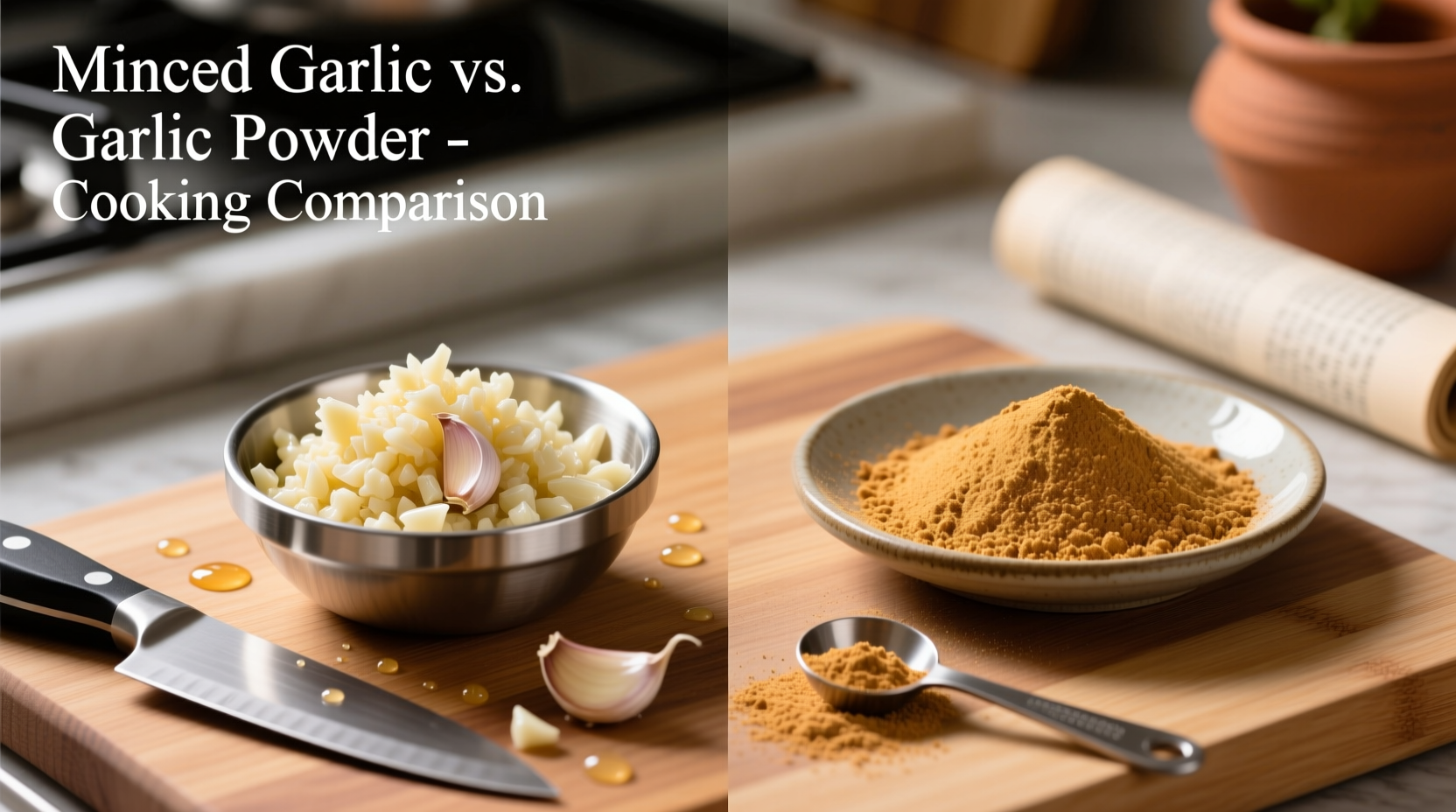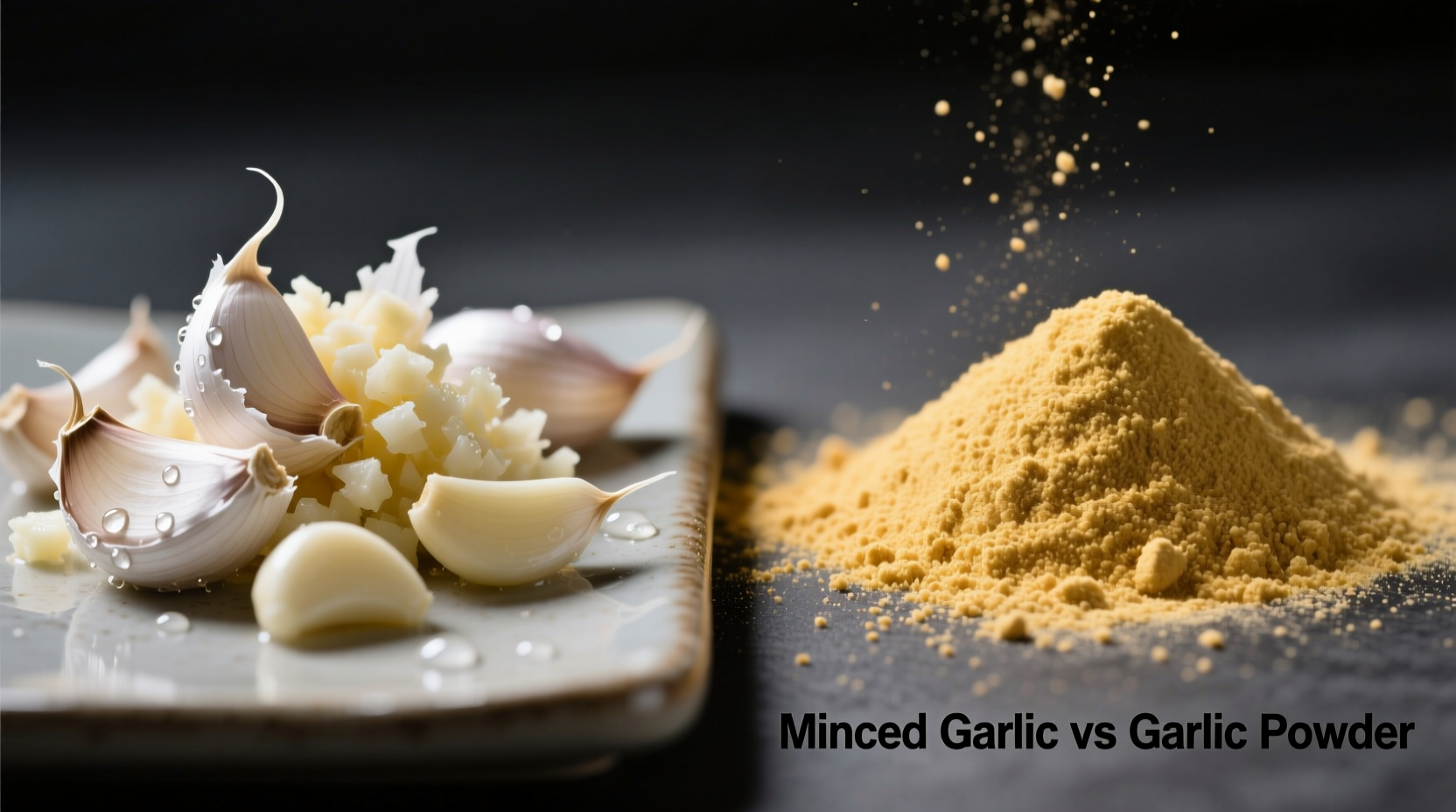Ever stood in your kitchen wondering whether to reach for the jar of minced garlic or the spice cabinet's garlic powder? You're not alone. Understanding the key differences between minced garlic and garlic powder can transform your cooking from good to extraordinary. This guide delivers precise substitution ratios, flavor chemistry insights, and professional chef recommendations so you'll never second-guess your garlic choice again.
Core Differences: Flavor, Texture, and Chemistry
Garlic's transformation from fresh bulb to processed form creates significant chemical changes that impact your dishes. When garlic cells are damaged through chopping or crushing, the enzyme alliinase converts alliin into allicin—the compound responsible for garlic's characteristic aroma and health benefits. This reaction happens immediately with fresh minced garlic but occurs differently in powdered form.
| Characteristic | Minced Garlic (Fresh) | Garlic Powder |
|---|---|---|
| Allicin Content | High (peaks at 30-60 seconds after mincing) | Low (most allicin degrades during drying) |
| Flavor Profile | Sharp, pungent, complex with sweet undertones | Milder, more uniform, slightly sweet |
| Moisture Content | Approximately 62% | Less than 6.5% (FDA standard) |
| Shelf Life (opened) | 1-2 weeks refrigerated | 2-3 years in cool, dark place |
| Substitution Ratio | 1 clove = 1/2 teaspoon powder | 1/2 tsp = 1 fresh clove |
When Minced Garlic Shines: Optimal Applications
Fresh minced garlic delivers maximum flavor impact in dishes where garlic plays a starring role. The USDA's Agricultural Research Service confirms that fresh garlic contains higher concentrations of volatile sulfur compounds that create more complex flavor profiles during cooking.
Best uses for minced garlic:
- Raw applications: Salad dressings, aiolis, and marinades where fresh pungency enhances other ingredients
- Quick-cooking dishes: Stir-fries and sautés where garlic needs 30-60 seconds to develop flavor without burning
- Finishing touches: Added in the last minute of cooking to preserve volatile compounds
- Garlic-infused oils: Creates immediate flavor transfer without the risk of botulism associated with whole cloves
Professional chefs like Antonio Rodriguez emphasize that "fresh minced garlic's enzymatic reaction creates hundreds of flavor compounds that simply don't exist in powdered form. For dishes where garlic is the star—like aglio e olio or garlic bread—nothing substitutes for the real thing."

Garlic Powder's Strategic Advantages
While lacking fresh garlic's complexity, garlic powder offers unique benefits that make it indispensable in certain cooking scenarios. According to research published in the Journal of Food Science, garlic powder provides more consistent flavor distribution in dry applications and withstands prolonged cooking without burning.
Optimal uses for garlic powder:
- Dry rubs and spice blends: Even distribution without moisture pockets that can cause uneven browning
- Long-simmering dishes: Soups, stews, and sauces where fresh garlic would break down and become bitter
- Baking applications: Bread doughs and savory pastries where moisture control is critical
- Commercial food production: Consistent flavor profile across batches (critical for food manufacturers)
Food scientists at the University of California note that garlic powder's lower moisture content prevents the Maillard reaction from occurring too quickly, making it ideal for applications where controlled browning is essential.
Precision Substitution Guide
Getting substitutions wrong can ruin a dish. Our conversion guide accounts for both flavor intensity and moisture differences:
- Minced to powder: 1 fresh clove minced = 1/8 to 1/4 teaspoon garlic powder (use 1/2 teaspoon for stronger garlic flavor)
- Powder to minced: 1/2 teaspoon garlic powder = 1 medium fresh clove (about 5g)
- Adjust liquid: When substituting powder for fresh, reduce other liquids by 1 teaspoon per clove replaced
- Timing matters: Add garlic powder early in cooking for maximum flavor integration; add minced garlic later to preserve freshness
Remember that jarred minced garlic (preserved in citric acid) falls between fresh and powder in intensity—use 1/2 teaspoon jarred for 1 fresh clove.
Avoiding Common Garlic Mistakes
Even experienced cooks make these critical errors:
- Burning garlic powder: It scorches at lower temperatures than fresh—never add directly to hot oil
- Over-substituting: Using equal volumes instead of adjusting for intensity differences
- Ignoring freshness: Garlic powder loses potency after 6 months—check for strong aroma before using
- Mixing forms incorrectly: Combining fresh and powder without adjusting quantities creates unbalanced flavor
For authentic Italian cooking, always use fresh minced garlic. In contrast, American-style barbecue rubs benefit from garlic powder's consistent distribution. Understanding these context boundaries for minced garlic versus garlic powder prevents culinary disasters.
Professional Chef Recommendations
Top chefs employ strategic garlic layering for maximum flavor impact:
- Build flavor foundations: Start with 1/4 teaspoon garlic powder in oil before adding fresh minced garlic
- Preserve freshness: Add half your garlic midway through cooking, half in the last 2 minutes
- Enhance umami: Combine 1/8 teaspoon garlic powder with fresh minced for restaurant-quality depth
- Prevent bitterness: Never cook garlic above 375°F (190°C)—use lower heat with powder
As Antonio Rodriguez explains, "The magic happens when you understand garlic's chemistry. Fresh provides the high notes, powder gives the bass line—use both strategically for symphonic flavor."
Storage and Shelf Life Considerations
Proper storage maintains garlic's quality and prevents waste:
- Minced garlic (fresh): Store in airtight container in refrigerator for up to 2 weeks
- Minced garlic (jarred): Refrigerate after opening; use within 18 months
- Garlic powder: Keep in cool, dark place; replace after 2 years for optimal flavor
- Test freshness: Rub between fingers—fresh powder should leave yellow oil stain
The National Center for Home Food Preservation confirms that garlic powder maintains its antioxidant properties significantly longer than fresh forms, making it valuable for long-term storage.











 浙公网安备
33010002000092号
浙公网安备
33010002000092号 浙B2-20120091-4
浙B2-20120091-4